Home / Optical Purity and Enantiomeric Excess
Stereochemistry and Chirality
Optical Purity and Enantiomeric Excess
Last updated: September 23rd, 2024 |
All About Optical Purity and Enantiomeric Excess
What is a racemic mixture? What is “optically active”, “optically inactive”, and “optically pure”. What do the terms, “l” and “d” mean? What is the formula for optical purity? What is the difference between optical purity and enantiomeric excess? [OK, that one’s quick: they’re the same thing].
In this post we answer all these burning questions, and do some worked examples of optical purity and enantiomeric excess besides.
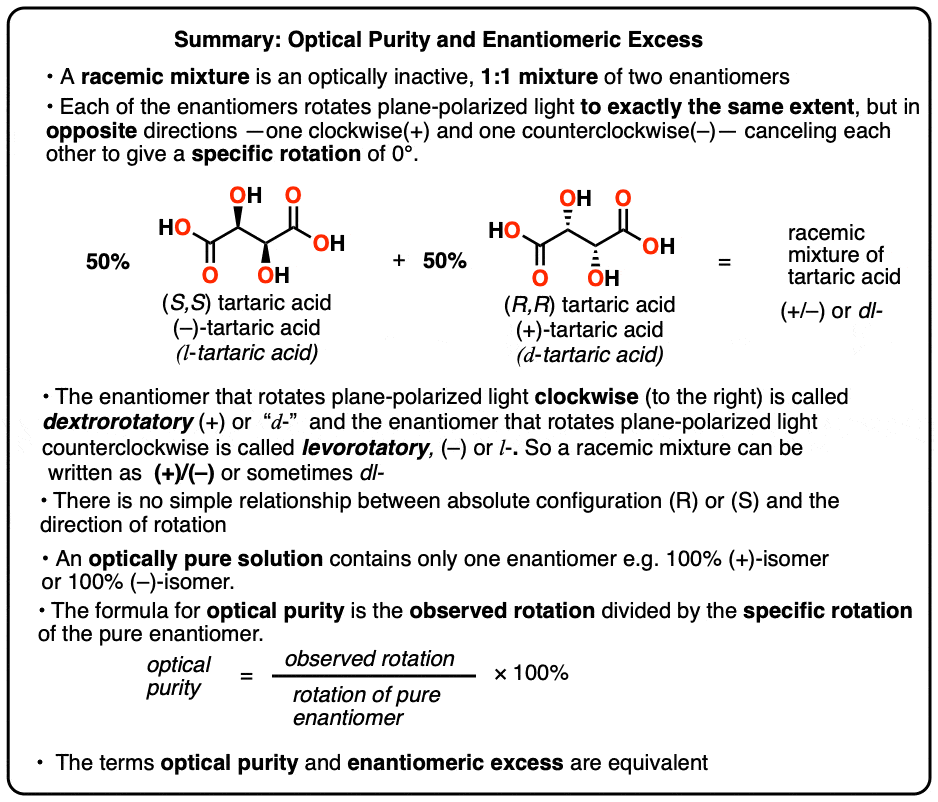
Table of Contents
- Louis Pasteur and The Discovery Of “Enantiomers”
- A Racemic Mixture Is An Equal Mixture Of Two Enantiomers And Has A Specific Rotation of 0° (Optically Inactive)
- An “Optically Pure” Solution Contains Only One Enantiomer
- The Terms “l-” And “d-” Refer To The “Levorotatory (–)” And “Dextrorotatory (+)” Forms Of Each Enantiomer
- The Formula For Optical Purity
- Using “Optical Purity” To Determinine The Molar Composition Of A Mixture
- Optical Purity = Enantiomeric Excess
- Another Practice Problem For Enantiomeric Excess
- An Optical Purity Practice Problem
- Notes
This post was co-authored with Matt Pierce of Organic Chemistry Solutions. Ask Matt about scheduling an online tutoring session here.
1. Louis Pasteur And The Discovery Of “Enantiomers”
In our last post on optical rotation (See post: Optical Rotation, Optical Activity, and Specific Rotation) we saw that when Louis Pasteur crystallized a salt of a compound then known as “racemic acid” he discovered that it formed two different types of crystals.
When redissolved in water, one set of crystals rotated plane-polarized light clockwise (dextrorotatory, “to the right”).
The other set of crystals rotated plane-polarized light to exactly the same extent, but counterclockwise (levorotatory, “to the left”).
This was surprising for two reasons.
- First, racemic acid was thought at the time to be a single compound. It turned out to be a 50:50 mixture of two compounds!
- Second, racemic acid did not rotate plane-polarized light: in other words, it was optically inactive. However, each of the two components were themselves optically active: they rotated plane polarized light to equal and opposite extents.
This immediately explained why racemic acid is optically inactive: just like two equal and opposite vectors cancel to give zero, the equal and opposite rotations due to each component cancel each other out.
Pasteur also noticed that the crystal forms were mirror images of each other. Then, in a leap of insight made without knowing the precise structure of the molecule, he then proposed that the molecules themselves were mirror images of each other. [Note 1]
We now know this to be true. We call two molecules that are non-superimposable mirror images of each other, “enantiomers”.
(Molecules that are superimposable mirror images, we just call, “the same molecule”. In chemistry, “∀” is just “A” that’s been rotated)
2. A Racemic Mixture Is An Equal Mixture Of Two Enantiomers And Has A Specific Rotation of 0° (Optically Inactive)
The two components of “racemic acid” are (2S,3S)-tartaric acid, which is levorotatory, or (–); and (2R, 3R) tartaric acid, which is dextrotoratory, or (+). They are enantiomers of each other: stereoisomers which are non-superimposable mirror images.
We now use the term “racemic mixture” to refer to a 50:50 mixture of two enantiomers. (“Racemic” comes from the Latin racemus, or “a bunch of grapes”, a nod to the fact that tartaric acid crystals are also known as “wine diamonds”)
So Pasteur’s achievement was the first resolution of a racemic mixture.
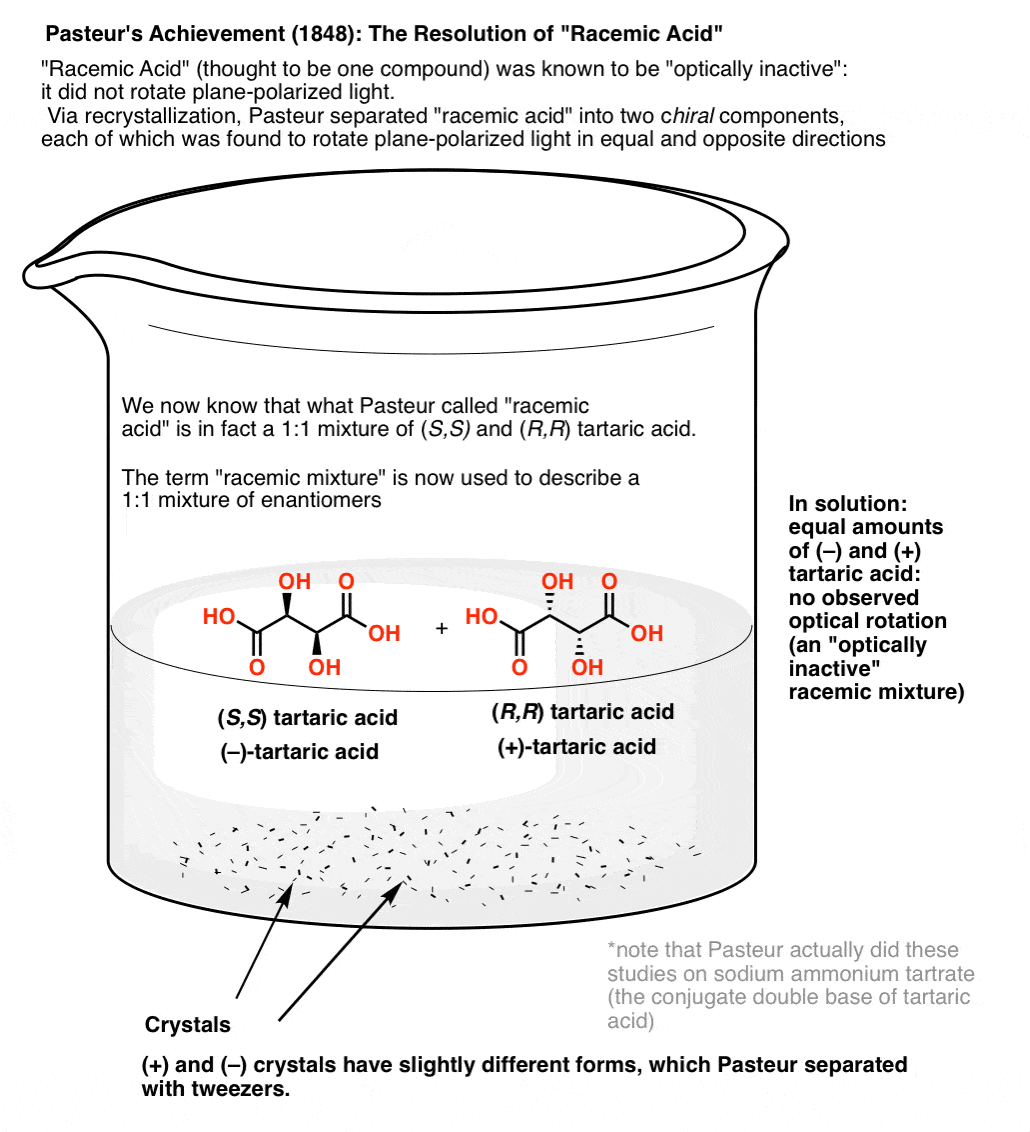
3. An “Optically Pure” Solution Contains Only One Enantiomer
As we said, the two enantiomers of tartaric acid rotate plane-polarized light to equal and opposite extents. In the last post we introduced a more precise way of saying this, in that the two enantiomers of tartaric acid have equal and opposite specific rotations.
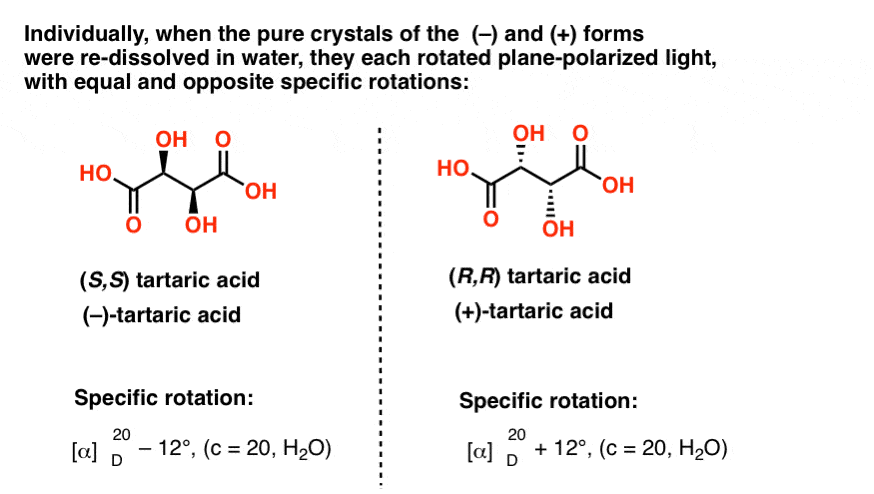
These “specific rotations” have to be measured experimentally: there’s no simple correlation between the configuration of a chiral centre (R or S) and the optical rotation.
This term “specific rotation” means that for the given concentration, temperature, wavelength, and solvent
- An “optically pure” (or “enantiomerically pure”) solution of 100% (S,S) tartaric acid and 0% (R,R) tartaric acid will have an optical rotation of –12°.
- An “optically pure” solution of 100% (R,R) tartaric acid and 0% (S,S) tartaric acid will have an optical rotation of +12° .
We’ve also seen that a “racemic mixture” of 50% (S,S) tartaric acid and 50% (R,R) tartaric acid will have an optical rotation of 0°.
4. The Terms “l-” And “d-” Refer To The “Levorotatory (–)” And “Dextrorotatory (+)” Forms Of Each Enantiomer
If we call the “levorotatory” (–) form of tartaric acid “l-” and the “dextrorotatory” (+) form of tartaric acid “d-“, then we can make the following three points on a graph. [note: in the real world, this graph is not always so linear, but it will do for our purposes]
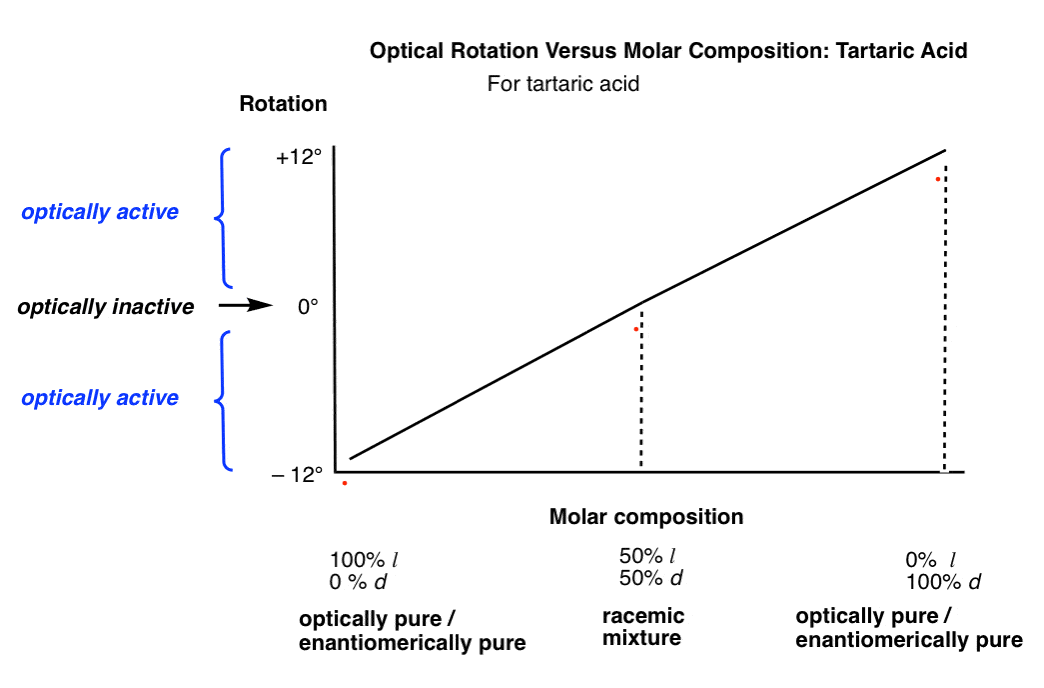
100% optically pure l-tartaric acid has a specific rotation of –12°, which gradually rises to 0° as the proportion of the d enantiomer is raised to 50%. As the the molar composition of the d form increases, so does the optical rotation, going up to +12° again for the optically pure d-enantiomer.
5. The Formula For Optical Purity
This suggests an idea. Let’s say you had a non-racemic but optically impure mixture of l and d enantiomers, a situation that arises quite frequently in modern organic chemistry [Note 2].
By measuring the optical rotation of the mixture for a compound whose specific rotation is known, you can figure out its optical purity and could work backwards to determine the ratio of enantiomers. [Note 3]
For example, let’s say you had a mixture of enantiomers of tartaric acid that has an observed rotation of +6° .
We can define the optical purity as the observed rotation of a mixture divided by the specific rotation of the pure enantiomer (obtained under identical conditions).

For our solution of tartaric acid with an observed rotation of +6°, our optical purity would be 50%

6. Going From “Optical Purity” To Determining The Molar Composition Of The Mixture
Now comes the part which sometimes trips people up. What’s the molar composition of the mixture?
Your first answer might be 50:50. 50% d- and 50% l- .
But when you think about it, that can’t be right: a 50-50 mixture would be racemic, which would have no optical rotation at all!
An “optical purity” of 50% actually means that the major enantiomer (d- in this case, since the solution is dextrorotatory) is present in 50% excess over the minor enantiomer. (l-)
The molar composition of the l- and d- forms must add up to 100%:

So using some basic algebra, we can use these two equations to calculate the ratio of enantiomers.
For instance, in equation #2, we can isolate the % of d- as being (50% + % l- ). We can then plug that value into equation #1 and we obtain the value for % l- as 25%. The value for % d- must then be 75%.
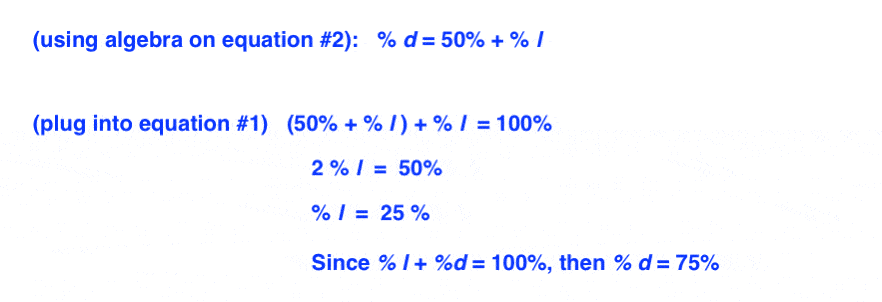
So, far from being 50-50, a mixture with 50% optical purity is actually a 75% : 25% mixture of enantiomers.
One way of looking at a 50% value for “optical purity” is that it’s 50% the dominant enantiomer, and 50% a racemic mixture.
7. Optical Purity = Enantiomeric Excess
If you do the math in the above example, you’ll note that the percentage of the d– enantiomer (75%) exceeds the percentage of the l- enantiomer (25%) by 50%. This also happens to be the value we calculated for optical purity.
Thus, the optical purity is thus equal to the percentage excess of the major enantiomer over the minor enantiomer.
This term, the “enantiomeric excess”, or “e.e.” for short, is equivalent to the optical purity and is actually used far more often for expressing the enantiomeric purity of a mixture.
So an “optically pure” solution containing 100% of the d – enantiomer and 0% of the l- enantiomer would have an enantiomeric excess of:
100% – 0% = 100%
The same would be true for an optically pure solution of the l- enantiomer: 100% e.e.
A racemic mixture, as we saw, has an optical purity of 0%. And so, too, the enantiomeric excess is also 0%.
50%d – 50% l = 0%
8. Another Practice Problem For Enantiomeric Excess
Let’s do another problem!
A sample of 2-bromobutane has an enantiomeric excess (e.e.) of 75% favouring the d– enantiomer. What is the percentage of each enantiomer?
First, identify the relevant equations:
e.e. = %d – %l = 75%
%d- + %l- = 100%
Next, solve one equation for either variable so you can plug that into the other equation. In this case we arbitrarily solve for the % of the d– enantiomer using the second equation.

Now, plug in what we found to the first equation, solving in this case for the percent of the d- enantiomer.

Then, solve for %d with our knowledge that the total equals 100%.

The previous two steps contain the answer, but we can also double check by plugging these numbers into the equation for e.e.

So a mixture with 75% ee is actually composed of 87.5% of the major enantiomer, and 12.5% of the minor enantiomer.
As we said above, another way of looking at it is that it’s 75% composed of the major enantiomer, and 25% of a racemic mixture.
9. An Optical Purity Practice Problem
Let’s do a slightly different problem, this time using optical purity.
A mixture contains 3g of (+)-2-bromobutane and 2g of (–)-2-bromobutane. What is the rotation of the mixture, given that (+)-2-bromobutane has a specific rotation of +23.1°.
First, let’s calculate enantiomeric excess/optical purity as a decimal number. Note that the units here (grams) will cancel.
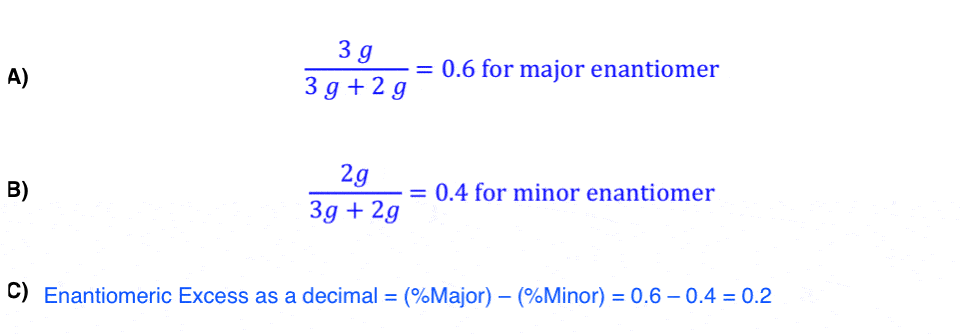
Now, we’ll solve for the rotation of the mixture using the equation for optical purity. Again, we’ll use the decimal form, which is 0.2 , for optical purity (or enantiomeric excess).

This gives us a rotation of 4.62° for the mixture.
That’s it! By the way, this is about as intense as math will ever get in introductory organic chemistry. You’re welcome.
This ends our two part discussion of optical activity, polarimetry, specific rotation, and optical purity.
Questions or comments about this post? Leave one below!
Thanks again to Matt for helping with this post. Hire Matt as your tutor!
Notes
Related Articles
Note 1. This was proposed in 1848, about 25 years before Van’t Hoff proposed tetrahedral carbon. Pasteur’s work was one of the foundations on which Van’t Hoff made his proposal; a carbon with 4 different groups can only exist as two different enantiomers if the carbon is tetrahedral. It’s impossible if carbon is square planar.
Note 2. These situations frequently come about when using an enantioselective reaction on an achiral compound, such as the epoxidation reaction that won Barry Sharpless the 2001 Nobel Prize (fittingly, this reaction employs the enantiomers of tartaric acid to impart “handedness” to the product). Enzymes are likely a more familiar category of enantioselective catalysts: Baker’s yeast has been used for the enantioselective reduction of ketones, for instance.
Note 3. Optical rotation measurements (i.e. polarimetry) are actually an unreliable way to determine enantiomeric excess. There are three reasons.
- The optical rotation of the pure enantiomers may not be known
- Small amount of optically active impurities may cause the experiment to give drastically incorrect results [UPDATE: Like in the real-life example of Frondisin B].
- Optical rotation doesn’t always have a linear relationship to enantiomeric excess like we’re claiming it does here. This is because of the Horeau Effect.
A more common way to measure enantiomeric excess is through HPLC or GC with a chiral stationary phase, or through the Mosher method.
00 General Chemistry Review
01 Bonding, Structure, and Resonance
- How Do We Know Methane (CH4) Is Tetrahedral?
- Hybrid Orbitals and Hybridization
- How To Determine Hybridization: A Shortcut
- Orbital Hybridization And Bond Strengths
- Sigma bonds come in six varieties: Pi bonds come in one
- A Key Skill: How to Calculate Formal Charge
- The Four Intermolecular Forces and How They Affect Boiling Points
- 3 Trends That Affect Boiling Points
- How To Use Electronegativity To Determine Electron Density (and why NOT to trust formal charge)
- Introduction to Resonance
- How To Use Curved Arrows To Interchange Resonance Forms
- Evaluating Resonance Forms (1) - The Rule of Least Charges
- How To Find The Best Resonance Structure By Applying Electronegativity
- Evaluating Resonance Structures With Negative Charges
- Evaluating Resonance Structures With Positive Charge
- Exploring Resonance: Pi-Donation
- Exploring Resonance: Pi-acceptors
- In Summary: Evaluating Resonance Structures
- Drawing Resonance Structures: 3 Common Mistakes To Avoid
- How to apply electronegativity and resonance to understand reactivity
- Bond Hybridization Practice
- Structure and Bonding Practice Quizzes
- Resonance Structures Practice
02 Acid Base Reactions
- Introduction to Acid-Base Reactions
- Acid Base Reactions In Organic Chemistry
- The Stronger The Acid, The Weaker The Conjugate Base
- Walkthrough of Acid-Base Reactions (3) - Acidity Trends
- Five Key Factors That Influence Acidity
- Acid-Base Reactions: Introducing Ka and pKa
- How to Use a pKa Table
- The pKa Table Is Your Friend
- A Handy Rule of Thumb for Acid-Base Reactions
- Acid Base Reactions Are Fast
- pKa Values Span 60 Orders Of Magnitude
- How Protonation and Deprotonation Affect Reactivity
- Acid Base Practice Problems
03 Alkanes and Nomenclature
- Meet the (Most Important) Functional Groups
- Condensed Formulas: Deciphering What the Brackets Mean
- Hidden Hydrogens, Hidden Lone Pairs, Hidden Counterions
- Don't Be Futyl, Learn The Butyls
- Primary, Secondary, Tertiary, Quaternary In Organic Chemistry
- Branching, and Its Affect On Melting and Boiling Points
- The Many, Many Ways of Drawing Butane
- Wedge And Dash Convention For Tetrahedral Carbon
- Common Mistakes in Organic Chemistry: Pentavalent Carbon
- Table of Functional Group Priorities for Nomenclature
- Summary Sheet - Alkane Nomenclature
- Organic Chemistry IUPAC Nomenclature Demystified With A Simple Puzzle Piece Approach
- Boiling Point Quizzes
- Organic Chemistry Nomenclature Quizzes
04 Conformations and Cycloalkanes
- Staggered vs Eclipsed Conformations of Ethane
- Conformational Isomers of Propane
- Newman Projection of Butane (and Gauche Conformation)
- Introduction to Cycloalkanes
- Geometric Isomers In Small Rings: Cis And Trans Cycloalkanes
- Calculation of Ring Strain In Cycloalkanes
- Cycloalkanes - Ring Strain In Cyclopropane And Cyclobutane
- Cyclohexane Conformations
- Cyclohexane Chair Conformation: An Aerial Tour
- How To Draw The Cyclohexane Chair Conformation
- The Cyclohexane Chair Flip
- The Cyclohexane Chair Flip - Energy Diagram
- Substituted Cyclohexanes - Axial vs Equatorial
- Ranking The Bulkiness Of Substituents On Cyclohexanes: "A-Values"
- Cyclohexane Chair Conformation Stability: Which One Is Lower Energy?
- Fused Rings - Cis-Decalin and Trans-Decalin
- Naming Bicyclic Compounds - Fused, Bridged, and Spiro
- Bredt's Rule (And Summary of Cycloalkanes)
- Newman Projection Practice
- Cycloalkanes Practice Problems
05 A Primer On Organic Reactions
- The Most Important Question To Ask When Learning a New Reaction
- Curved Arrows (for reactions)
- Nucleophiles and Electrophiles
- The Three Classes of Nucleophiles
- Nucleophilicity vs. Basicity
- What Makes A Good Nucleophile?
- What Makes A Good Leaving Group?
- 3 Factors That Stabilize Carbocations
- Equilibrium and Energy Relationships
- 7 Factors that stabilize negative charge in organic chemistry
- 7 Factors That Stabilize Positive Charge in Organic Chemistry
- What's a Transition State?
- Hammond's Postulate
- Learning Organic Chemistry Reactions: A Checklist (PDF)
- Introduction to Oxidative Cleavage Reactions
06 Free Radical Reactions
- Bond Dissociation Energies = Homolytic Cleavage
- Free Radical Reactions
- 3 Factors That Stabilize Free Radicals
- What Factors Destabilize Free Radicals?
- Bond Strengths And Radical Stability
- Free Radical Initiation: Why Is "Light" Or "Heat" Required?
- Initiation, Propagation, Termination
- Monochlorination Products Of Propane, Pentane, And Other Alkanes
- Selectivity In Free Radical Reactions
- Selectivity in Free Radical Reactions: Bromination vs. Chlorination
- Halogenation At Tiffany's
- Allylic Bromination
- Bonus Topic: Allylic Rearrangements
- In Summary: Free Radicals
- Synthesis (2) - Reactions of Alkanes
- Free Radicals Practice Quizzes
07 Stereochemistry and Chirality
- Types of Isomers: Constitutional Isomers, Stereoisomers, Enantiomers, and Diastereomers
- How To Draw The Enantiomer Of A Chiral Molecule
- How To Draw A Bond Rotation
- Introduction to Assigning (R) and (S): The Cahn-Ingold-Prelog Rules
- Assigning Cahn-Ingold-Prelog (CIP) Priorities (2) - The Method of Dots
- Enantiomers vs Diastereomers vs The Same? Two Methods For Solving Problems
- Assigning R/S To Newman Projections (And Converting Newman To Line Diagrams)
- How To Determine R and S Configurations On A Fischer Projection
- The Meso Trap
- Optical Rotation, Optical Activity, and Specific Rotation
- Optical Purity and Enantiomeric Excess
- What's a Racemic Mixture?
- Chiral Allenes And Chiral Axes
- Stereochemistry Practice Problems and Quizzes
08 Substitution Reactions
- Nucleophilic Substitution Reactions - Introduction
- Two Types of Nucleophilic Substitution Reactions
- The SN2 Mechanism
- Why the SN2 Reaction Is Powerful
- The SN1 Mechanism
- The Conjugate Acid Is A Better Leaving Group
- Comparing the SN1 and SN2 Reactions
- Polar Protic? Polar Aprotic? Nonpolar? All About Solvents
- Steric Hindrance is Like a Fat Goalie
- Common Blind Spot: Intramolecular Reactions
- Substitution Practice - SN1
- Substitution Practice - SN2
09 Elimination Reactions
- Elimination Reactions (1): Introduction And The Key Pattern
- Elimination Reactions (2): The Zaitsev Rule
- Elimination Reactions Are Favored By Heat
- Two Elimination Reaction Patterns
- The E1 Reaction
- The E2 Mechanism
- E1 vs E2: Comparing the E1 and E2 Reactions
- Antiperiplanar Relationships: The E2 Reaction and Cyclohexane Rings
- Bulky Bases in Elimination Reactions
- Comparing the E1 vs SN1 Reactions
- Elimination (E1) Reactions With Rearrangements
- E1cB - Elimination (Unimolecular) Conjugate Base
- Elimination (E1) Practice Problems And Solutions
- Elimination (E2) Practice Problems and Solutions
10 Rearrangements
11 SN1/SN2/E1/E2 Decision
- Identifying Where Substitution and Elimination Reactions Happen
- Deciding SN1/SN2/E1/E2 (1) - The Substrate
- Deciding SN1/SN2/E1/E2 (2) - The Nucleophile/Base
- SN1 vs E1 and SN2 vs E2 : The Temperature
- Deciding SN1/SN2/E1/E2 - The Solvent
- Wrapup: The Key Factors For Determining SN1/SN2/E1/E2
- Alkyl Halide Reaction Map And Summary
- SN1 SN2 E1 E2 Practice Problems
12 Alkene Reactions
- E and Z Notation For Alkenes (+ Cis/Trans)
- Alkene Stability
- Alkene Addition Reactions: "Regioselectivity" and "Stereoselectivity" (Syn/Anti)
- Stereoselective and Stereospecific Reactions
- Hydrohalogenation of Alkenes and Markovnikov's Rule
- Hydration of Alkenes With Aqueous Acid
- Rearrangements in Alkene Addition Reactions
- Halogenation of Alkenes and Halohydrin Formation
- Oxymercuration Demercuration of Alkenes
- Hydroboration Oxidation of Alkenes
- m-CPBA (meta-chloroperoxybenzoic acid)
- OsO4 (Osmium Tetroxide) for Dihydroxylation of Alkenes
- Palladium on Carbon (Pd/C) for Catalytic Hydrogenation of Alkenes
- Cyclopropanation of Alkenes
- A Fourth Alkene Addition Pattern - Free Radical Addition
- Alkene Reactions: Ozonolysis
- Summary: Three Key Families Of Alkene Reaction Mechanisms
- Synthesis (4) - Alkene Reaction Map, Including Alkyl Halide Reactions
- Alkene Reactions Practice Problems
13 Alkyne Reactions
- Acetylides from Alkynes, And Substitution Reactions of Acetylides
- Partial Reduction of Alkynes With Lindlar's Catalyst
- Partial Reduction of Alkynes With Na/NH3 To Obtain Trans Alkenes
- Alkyne Hydroboration With "R2BH"
- Hydration and Oxymercuration of Alkynes
- Hydrohalogenation of Alkynes
- Alkyne Halogenation: Bromination, Chlorination, and Iodination of Alkynes
- Alkyne Reactions - The "Concerted" Pathway
- Alkenes To Alkynes Via Halogenation And Elimination Reactions
- Alkynes Are A Blank Canvas
- Synthesis (5) - Reactions of Alkynes
- Alkyne Reactions Practice Problems With Answers
14 Alcohols, Epoxides and Ethers
- Alcohols - Nomenclature and Properties
- Alcohols Can Act As Acids Or Bases (And Why It Matters)
- Alcohols - Acidity and Basicity
- The Williamson Ether Synthesis
- Ethers From Alkenes, Tertiary Alkyl Halides and Alkoxymercuration
- Alcohols To Ethers via Acid Catalysis
- Cleavage Of Ethers With Acid
- Epoxides - The Outlier Of The Ether Family
- Opening of Epoxides With Acid
- Epoxide Ring Opening With Base
- Making Alkyl Halides From Alcohols
- Tosylates And Mesylates
- PBr3 and SOCl2
- Elimination Reactions of Alcohols
- Elimination of Alcohols To Alkenes With POCl3
- Alcohol Oxidation: "Strong" and "Weak" Oxidants
- Demystifying The Mechanisms of Alcohol Oxidations
- Protecting Groups For Alcohols
- Thiols And Thioethers
- Calculating the oxidation state of a carbon
- Oxidation and Reduction in Organic Chemistry
- Oxidation Ladders
- SOCl2 Mechanism For Alcohols To Alkyl Halides: SN2 versus SNi
- Alcohol Reactions Roadmap (PDF)
- Alcohol Reaction Practice Problems
- Epoxide Reaction Quizzes
- Oxidation and Reduction Practice Quizzes
15 Organometallics
- What's An Organometallic?
- Formation of Grignard and Organolithium Reagents
- Organometallics Are Strong Bases
- Reactions of Grignard Reagents
- Protecting Groups In Grignard Reactions
- Synthesis Problems Involving Grignard Reagents
- Grignard Reactions And Synthesis (2)
- Organocuprates (Gilman Reagents): How They're Made
- Gilman Reagents (Organocuprates): What They're Used For
- The Heck, Suzuki, and Olefin Metathesis Reactions (And Why They Don't Belong In Most Introductory Organic Chemistry Courses)
- Reaction Map: Reactions of Organometallics
- Grignard Practice Problems
16 Spectroscopy
- Degrees of Unsaturation (or IHD, Index of Hydrogen Deficiency)
- Conjugation And Color (+ How Bleach Works)
- Introduction To UV-Vis Spectroscopy
- UV-Vis Spectroscopy: Absorbance of Carbonyls
- UV-Vis Spectroscopy: Practice Questions
- Bond Vibrations, Infrared Spectroscopy, and the "Ball and Spring" Model
- Infrared Spectroscopy: A Quick Primer On Interpreting Spectra
- IR Spectroscopy: 4 Practice Problems
- 1H NMR: How Many Signals?
- Homotopic, Enantiotopic, Diastereotopic
- Diastereotopic Protons in 1H NMR Spectroscopy: Examples
- 13-C NMR - How Many Signals
- Liquid Gold: Pheromones In Doe Urine
- Natural Product Isolation (1) - Extraction
- Natural Product Isolation (2) - Purification Techniques, An Overview
- Structure Determination Case Study: Deer Tarsal Gland Pheromone
17 Dienes and MO Theory
- What To Expect In Organic Chemistry 2
- Are these molecules conjugated?
- Conjugation And Resonance In Organic Chemistry
- Bonding And Antibonding Pi Orbitals
- Molecular Orbitals of The Allyl Cation, Allyl Radical, and Allyl Anion
- Pi Molecular Orbitals of Butadiene
- Reactions of Dienes: 1,2 and 1,4 Addition
- Thermodynamic and Kinetic Products
- More On 1,2 and 1,4 Additions To Dienes
- s-cis and s-trans
- The Diels-Alder Reaction
- Cyclic Dienes and Dienophiles in the Diels-Alder Reaction
- Stereochemistry of the Diels-Alder Reaction
- Exo vs Endo Products In The Diels Alder: How To Tell Them Apart
- HOMO and LUMO In the Diels Alder Reaction
- Why Are Endo vs Exo Products Favored in the Diels-Alder Reaction?
- Diels-Alder Reaction: Kinetic and Thermodynamic Control
- The Retro Diels-Alder Reaction
- The Intramolecular Diels Alder Reaction
- Regiochemistry In The Diels-Alder Reaction
- The Cope and Claisen Rearrangements
- Electrocyclic Reactions
- Electrocyclic Ring Opening And Closure (2) - Six (or Eight) Pi Electrons
- Diels Alder Practice Problems
- Molecular Orbital Theory Practice
18 Aromaticity
- Introduction To Aromaticity
- Rules For Aromaticity
- Huckel's Rule: What Does 4n+2 Mean?
- Aromatic, Non-Aromatic, or Antiaromatic? Some Practice Problems
- Antiaromatic Compounds and Antiaromaticity
- The Pi Molecular Orbitals of Benzene
- The Pi Molecular Orbitals of Cyclobutadiene
- Frost Circles
- Aromaticity Practice Quizzes
19 Reactions of Aromatic Molecules
- Electrophilic Aromatic Substitution: Introduction
- Activating and Deactivating Groups In Electrophilic Aromatic Substitution
- Electrophilic Aromatic Substitution - The Mechanism
- Ortho-, Para- and Meta- Directors in Electrophilic Aromatic Substitution
- Understanding Ortho, Para, and Meta Directors
- Why are halogens ortho- para- directors?
- Disubstituted Benzenes: The Strongest Electron-Donor "Wins"
- Electrophilic Aromatic Substitutions (1) - Halogenation of Benzene
- Electrophilic Aromatic Substitutions (2) - Nitration and Sulfonation
- EAS Reactions (3) - Friedel-Crafts Acylation and Friedel-Crafts Alkylation
- Intramolecular Friedel-Crafts Reactions
- Nucleophilic Aromatic Substitution (NAS)
- Nucleophilic Aromatic Substitution (2) - The Benzyne Mechanism
- Reactions on the "Benzylic" Carbon: Bromination And Oxidation
- The Wolff-Kishner, Clemmensen, And Other Carbonyl Reductions
- More Reactions on the Aromatic Sidechain: Reduction of Nitro Groups and the Baeyer Villiger
- Aromatic Synthesis (1) - "Order Of Operations"
- Synthesis of Benzene Derivatives (2) - Polarity Reversal
- Aromatic Synthesis (3) - Sulfonyl Blocking Groups
- Birch Reduction
- Synthesis (7): Reaction Map of Benzene and Related Aromatic Compounds
- Aromatic Reactions and Synthesis Practice
- Electrophilic Aromatic Substitution Practice Problems
20 Aldehydes and Ketones
- What's The Alpha Carbon In Carbonyl Compounds?
- Nucleophilic Addition To Carbonyls
- Aldehydes and Ketones: 14 Reactions With The Same Mechanism
- Sodium Borohydride (NaBH4) Reduction of Aldehydes and Ketones
- Grignard Reagents For Addition To Aldehydes and Ketones
- Wittig Reaction
- Hydrates, Hemiacetals, and Acetals
- Imines - Properties, Formation, Reactions, and Mechanisms
- All About Enamines
- Breaking Down Carbonyl Reaction Mechanisms: Reactions of Anionic Nucleophiles (Part 2)
- Aldehydes Ketones Reaction Practice
21 Carboxylic Acid Derivatives
- Nucleophilic Acyl Substitution (With Negatively Charged Nucleophiles)
- Addition-Elimination Mechanisms With Neutral Nucleophiles (Including Acid Catalysis)
- Basic Hydrolysis of Esters - Saponification
- Transesterification
- Proton Transfer
- Fischer Esterification - Carboxylic Acid to Ester Under Acidic Conditions
- Lithium Aluminum Hydride (LiAlH4) For Reduction of Carboxylic Acid Derivatives
- LiAlH[Ot-Bu]3 For The Reduction of Acid Halides To Aldehydes
- Di-isobutyl Aluminum Hydride (DIBAL) For The Partial Reduction of Esters and Nitriles
- Amide Hydrolysis
- Thionyl Chloride (SOCl2)
- Diazomethane (CH2N2)
- Carbonyl Chemistry: Learn Six Mechanisms For the Price Of One
- Making Music With Mechanisms (PADPED)
- Carboxylic Acid Derivatives Practice Questions
22 Enols and Enolates
- Keto-Enol Tautomerism
- Enolates - Formation, Stability, and Simple Reactions
- Kinetic Versus Thermodynamic Enolates
- Aldol Addition and Condensation Reactions
- Reactions of Enols - Acid-Catalyzed Aldol, Halogenation, and Mannich Reactions
- Claisen Condensation and Dieckmann Condensation
- Decarboxylation
- The Malonic Ester and Acetoacetic Ester Synthesis
- The Michael Addition Reaction and Conjugate Addition
- The Robinson Annulation
- Haloform Reaction
- The Hell–Volhard–Zelinsky Reaction
- Enols and Enolates Practice Quizzes
23 Amines
- The Amide Functional Group: Properties, Synthesis, and Nomenclature
- Basicity of Amines And pKaH
- 5 Key Basicity Trends of Amines
- The Mesomeric Effect And Aromatic Amines
- Nucleophilicity of Amines
- Alkylation of Amines (Sucks!)
- Reductive Amination
- The Gabriel Synthesis
- Some Reactions of Azides
- The Hofmann Elimination
- The Hofmann and Curtius Rearrangements
- The Cope Elimination
- Protecting Groups for Amines - Carbamates
- The Strecker Synthesis of Amino Acids
- Introduction to Peptide Synthesis
- Reactions of Diazonium Salts: Sandmeyer and Related Reactions
- Amine Practice Questions
24 Carbohydrates
- D and L Notation For Sugars
- Pyranoses and Furanoses: Ring-Chain Tautomerism In Sugars
- What is Mutarotation?
- Reducing Sugars
- The Big Damn Post Of Carbohydrate-Related Chemistry Definitions
- The Haworth Projection
- Converting a Fischer Projection To A Haworth (And Vice Versa)
- Reactions of Sugars: Glycosylation and Protection
- The Ruff Degradation and Kiliani-Fischer Synthesis
- Isoelectric Points of Amino Acids (and How To Calculate Them)
- Carbohydrates Practice
- Amino Acid Quizzes
25 Fun and Miscellaneous
- A Gallery of Some Interesting Molecules From Nature
- Screw Organic Chemistry, I'm Just Going To Write About Cats
- On Cats, Part 1: Conformations and Configurations
- On Cats, Part 2: Cat Line Diagrams
- On Cats, Part 4: Enantiocats
- On Cats, Part 6: Stereocenters
- Organic Chemistry Is Shit
- The Organic Chemistry Behind "The Pill"
- Maybe they should call them, "Formal Wins" ?
- Why Do Organic Chemists Use Kilocalories?
- The Principle of Least Effort
- Organic Chemistry GIFS - Resonance Forms
- Reproducibility In Organic Chemistry
- What Holds The Nucleus Together?
- How Reactions Are Like Music
- Organic Chemistry and the New MCAT
26 Organic Chemistry Tips and Tricks
- Common Mistakes: Formal Charges Can Mislead
- Partial Charges Give Clues About Electron Flow
- Draw The Ugly Version First
- Organic Chemistry Study Tips: Learn the Trends
- The 8 Types of Arrows In Organic Chemistry, Explained
- Top 10 Skills To Master Before An Organic Chemistry 2 Final
- Common Mistakes with Carbonyls: Carboxylic Acids... Are Acids!
- Planning Organic Synthesis With "Reaction Maps"
- Alkene Addition Pattern #1: The "Carbocation Pathway"
- Alkene Addition Pattern #2: The "Three-Membered Ring" Pathway
- Alkene Addition Pattern #3: The "Concerted" Pathway
- Number Your Carbons!
- The 4 Major Classes of Reactions in Org 1
- How (and why) electrons flow
- Grossman's Rule
- Three Exam Tips
- A 3-Step Method For Thinking Through Synthesis Problems
- Putting It Together
- Putting Diels-Alder Products in Perspective
- The Ups and Downs of Cyclohexanes
- The Most Annoying Exceptions in Org 1 (Part 1)
- The Most Annoying Exceptions in Org 1 (Part 2)
- The Marriage May Be Bad, But the Divorce Still Costs Money
- 9 Nomenclature Conventions To Know
- Nucleophile attacks Electrophile
27 Case Studies of Successful O-Chem Students
- Success Stories: How Corina Got The The "Hard" Professor - And Got An A+ Anyway
- How Helena Aced Organic Chemistry
- From a "Drop" To B+ in Org 2 – How A Hard Working Student Turned It Around
- How Serge Aced Organic Chemistry
- Success Stories: How Zach Aced Organic Chemistry 1
- Success Stories: How Kari Went From C– to B+
- How Esther Bounced Back From a "C" To Get A's In Organic Chemistry 1 And 2
- How Tyrell Got The Highest Grade In Her Organic Chemistry Course
- This Is Why Students Use Flashcards
- Success Stories: How Stu Aced Organic Chemistry
- How John Pulled Up His Organic Chemistry Exam Grades
- Success Stories: How Nathan Aced Organic Chemistry (Without It Taking Over His Life)
- How Chris Aced Org 1 and Org 2
- Interview: How Jay Got an A+ In Organic Chemistry
- How to Do Well in Organic Chemistry: One Student's Advice
- "America's Top TA" Shares His Secrets For Teaching O-Chem
- "Organic Chemistry Is Like..." - A Few Metaphors
- How To Do Well In Organic Chemistry: Advice From A Tutor
- Guest post: "I went from being afraid of tests to actually looking forward to them".
You are good with a variety of concepts
Hi James,
I always admire your website, in fact, I do recommend this to my students as well.
About the “The Formula For Optical Purity” you have mentioned
Optical purity or % ee = |observed rotation| / |specific rotation of pure|
However, I think it may be:
Optical purity or % ee = |observed specific rotation| / |specific rotation of pure|
Some times students may get confused with observed rotation and observed specific rotation.
Yes, thank you – that will be fixed shortly.
sir, still confuse in the above explanation whether ee is 25 or 75
By simply adding equation 1 and 2, one can get % of d enantiomer = 150/2 =75. Substituting this in any one of the equations will give % of d enantiomer to be 25.
problem in identifying the compound which is in excess in the racemic mixture when the %ee is 26.38, in such away that when you some the racemate do not give 100% help pls im in trouble with this confusion.